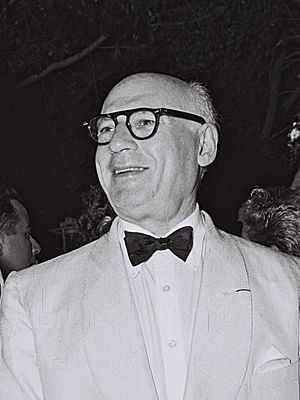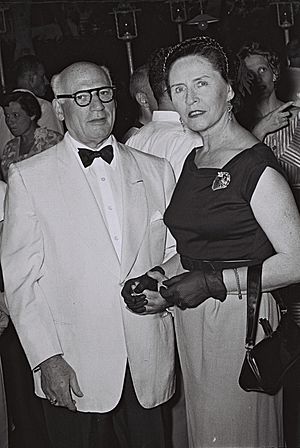Sol Hurok facts for kids
Quick facts for kids
Sol Hurok
|
|
|---|---|
| Соломон Израилевич Гурков | |

Hurok in 1954
|
|
| Born |
Solomon Izrailevich Gurkov
April 9, 1888 Pogar, Chernigov Governorate, Russian Empire
|
| Died | March 5, 1974 (aged 85) |
| Occupation | Impresario |
Sol Hurok (born Solomon Izrailevich Gurkov; April 9, 1888 – March 5, 1974) was a famous American impresario. An impresario is someone who organizes and manages concerts, operas, or ballets. Hurok helped many amazing artists share their talents with the world.
Contents
Early Life
Sol Hurok was born in 1888 in a place called Pogar, which was part of the Russian Empire. When he was 18, in 1906, he moved to the United States. He became an American citizen in 1914.
Sol Hurok's Career
Sol Hurok had a very long and successful career. His company, S. Hurok Presents, worked with many incredible performers. He helped manage the careers of dancers, singers, and musicians.
Some of the famous artists he worked with include:
- Marian Anderson (a legendary singer)
- Isadora Duncan (a pioneering dancer)
- Anna Pavlova (a famous ballerina)
- Arthur Rubinstein (a brilliant pianist)
- Isaac Stern (a celebrated violinist)
- Van Cliburn (a talented pianist)
- Mstislav Rostropovich (a great cellist)
- Margot Fonteyn (a prima ballerina)
Helping Marian Anderson
In 1935, the pianist Arthur Rubinstein introduced Hurok to the singer Marian Anderson. She chose Hurok to be her manager for the rest of her career. A few years later, Hurok played a big part in a historic event. He worked with Walter Francis White from the NAACP and First Lady Eleanor Roosevelt. Together, they helped arrange a special outdoor concert for Marian Anderson. This concert took place on April 9, 1939, on the steps of the Lincoln Memorial.
Bringing Ballet to America
Hurok also loved ballet. He managed two famous Russian ballet companies, the Original Ballet Russe and The Ballet Russe de Monte Carlo. He hoped to bring them together, but it didn't happen.
After trying for 35 years, Sol Hurok finally brought Russia's famous Bolshoi Ballet to the United States in 1959. They performed for eight weeks! He also brought the Kirov Academy of Ballet and the Igor Moiseyev Ballet Company to the U.S. in 1961. Even during the tense time of the Cuban Missile Crisis in 1962, he managed to bring the Bolshoi back for another tour.
Honoring His Work
Sol Hurok had a huge impact on American music and arts. In 1971, he received the University of Pennsylvania Glee Club Award of Merit. This award honors people who have made a big difference in the world of music.
Death
Sol Hurok passed away in 1974 from a heart attack. He was on his way to a meeting about a project with the famous dancer Rudolph Nureyev. More than two thousand people came to his funeral at Carnegie Hall. Marian Anderson, the singer he had helped so much, gave the final speech.
Cultural Depictions
Sol Hurok's life was so interesting that it inspired movies:
- Tonight We Sing (1953): A musical film where David Wayne played Sol Hurok.
- Anna Pavlova (1983): A film about the ballerina, where John Murray played Hurok.


